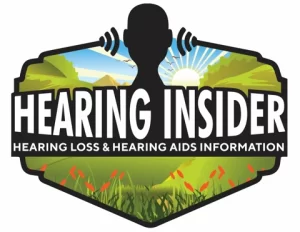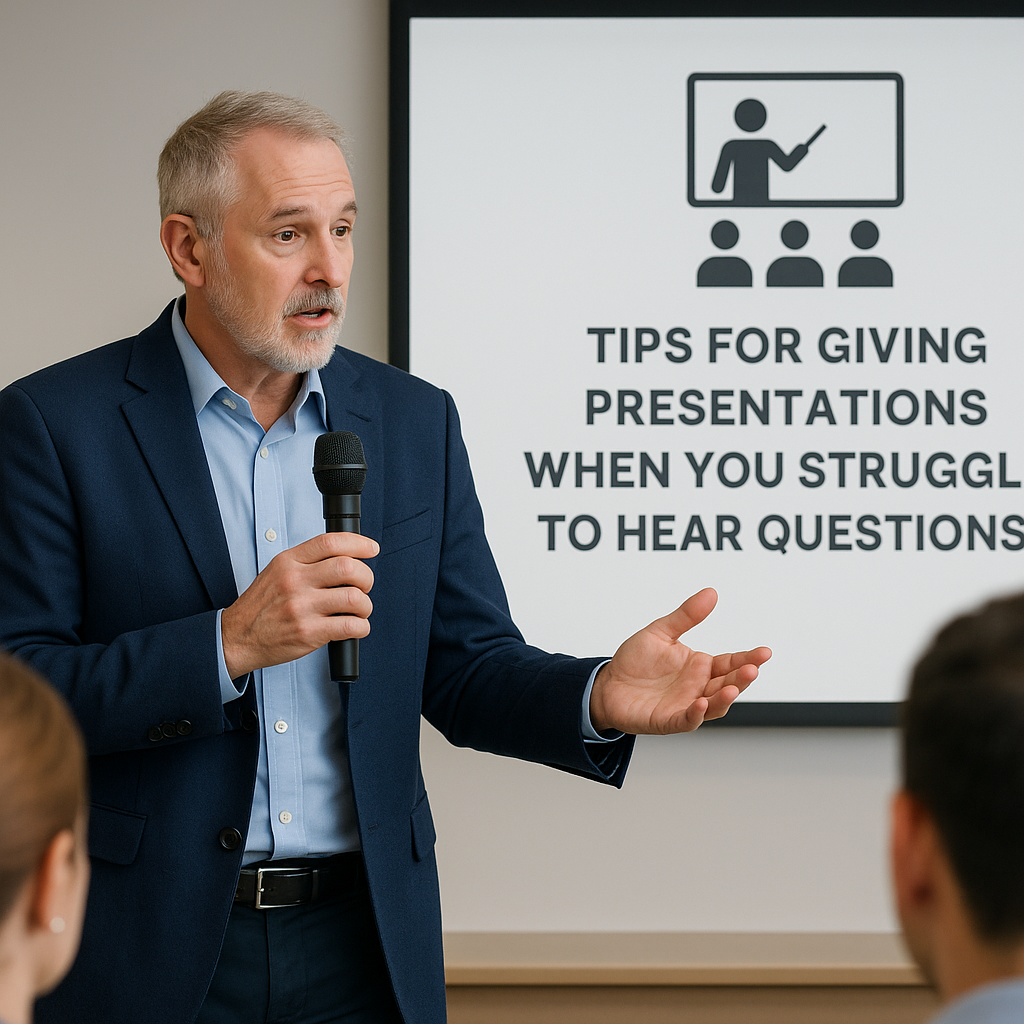If hearing questions is hard, front-load success: tell the room what you need, control the mic flow, turn on captions, repeat each question, and use a moderator or written Q&A as backup. Pack a remote mic / ALD and a one-slide Q&A instruction. Leave a way to follow up in writing.

1) Before the talk: set yourself up to hear
A) Email the organizer (template you can paste)
Subject: Quick accessibility request for Q&A
Hi [Name], to ensure I catch audience questions accurately, could we:
• Use a single audience mic (or have a moderator repeat each question).
• Keep front lights on during Q&A for lip-reading.
• Enable live captions (Zoom/Teams/Slides) if hybrid/recorded.
• Reserve front-row seating for Q&A askers if there’s no mic.
I may also bring a small remote mic/receiver. Thank you!
—[Your Name]
Why it helps: You’re creating mic discipline, lighting for speech-reading, and a caption plan before you step on stage.
B) Room, seating, and lighting
- Keep house lights up during Q&A to preserve visual cues.
- Position yourself closer to askers; avoid standing under noisy HVAC.
- If no audience mic, designate a “Q&A aisle” or askers to stand before speaking.
C) Tech stack (choose 1–2 you trust)
- Remote microphone / ALD: A handheld or clip-on mic routed to your hearing aids or receiver can be a game-changer when passed to audience members.
Learn more about assistive listening technologies from NIDCD. - Live captions: Turn on Zoom/Teams live captions or Google Slides captions. Ask participants to type questions in chat during hybrid events.
See the National Deaf Center’s guide to real-time captioning. - Question capture: Provide a QR code to a form or Slido/Mentimeter so questions arrive in writing as backup.
Deep dive next: your pillar Working Smarter with Hearing Challenges connects these strategies beyond the stage.
2) Open strong: disclose, set ground rules, reduce noise
Micro-script (10 seconds):
“To make Q&A accurate for everyone, please use the mic and speak one at a time. I’ll repeat each question before answering. If I miss something, I’ll ask you to repeat—thanks!”
- Keep side doors closed; ask ushers to pause traffic during Q&A.
- Post a Q&A slide (below) to reinforce the ground rules visually.
On-slide text you can copy:
Q&A Ground Rules
- One person at a time • 2) Use the mic / speak clearly • 3) I’ll repeat your question • 4) You can also scan the QR to submit in writing
Related reads that help with delivery:
• Everyday Etiquette: How to Ask Someone to Repeat
• Best Video Conferencing Tools Ranked for Clarity
3) During Q&A: hear better, answer better
- Repeat or rephrase every question: confirms accuracy and helps the whole room.
“So I heard ‘Do these results apply to younger patients?’—great question.” - Keep the mic moving: no mic, no question. If there’s no mic, askers stand and face you.
- Use “ask to repeat” scripts without apology:
- “Could you repeat that so I catch it exactly?”
- “Two parts: first was X—what was the second?”
- “One more time, a little slower—thank you.”
- Slow the room: make eye contact, hold your hand up slightly to stop overlap, and call on people by turn.
- Accents / fast talkers: invite them to type or hand you the mic; ask a moderator to echo their question.
For at-home or small-room practice, see Best Work-from-Home Setups for Clarity and Best Headphones for Productivity and Clarity.
4) Hybrid & virtual Q&A specifics
- Always enable captions. In Zoom/Teams, toggle “Live captions/subtitles.”
- Ask attendees to post questions in chat; have a moderator read them out.
- Wear a closed-back headset (if you don’t use hearing aids) to reduce echo/room noise.
- Share your last slide (summary + contact) on screen while fielding chat questions so you can see and process in real time.
More tools and comparisons: Best Video Conferencing Tools Ranked for Clarity.
5) If you miss a question entirely
- Own it briefly: “I didn’t catch that yet—I want to answer it well.”
- Choose a recovery:
- Ask them to repeat slower/closer to the mic.
- Ask your moderator to restate.
- Pivot to written: “Drop it in the chat/notecard and I’ll answer next.”
6) After the talk: close the loop
- Leave a follow-up email or QR to a 1-minute form for written questions.
- Share slides/one-pager with the key points and FAQs.
- Ask for quick feedback: “Were captions and Q&A flow clear today?”
7) Gear quick-start (what to bring and when)

| Tool (generic) | What it does | Best for | Watch-outs |
|---|---|---|---|
| Remote mic / ALD (handheld or clip) | Sends the asker’s voice directly to your receiver/hearing aids | In-person rooms without reliable audience mics | Needs battery + quick pairing practice |
| Venue ALD (FM/DM, loop, IR) | Taps the room/assistive system to your receiver | Larger venues/conferences | Coordinate with AV early |
| Single audience mic (or runner) | Enforces one-at-a-time, reduces crosstalk | Panels, auditoriums | Requires a moderator |
| Live captions (Zoom/Teams/Slides) | Real-time text of questions | Hybrid/virtual, recorded sessions | Accuracy varies; keep a moderator |
| Question form/QR | Written backup you can read clearly | Noisy rooms, fast accents | Needs pre-made link/QR |
For a broader productivity environment, see Working Smarter with Hearing Challenges.
8) Printable “Presenter Q&A Accessibility” checklist
- Email organizer with mic/lighting/captions requests
- Pack remote mic/receiver (+ spare batteries)
- Prepare QR link for written questions
- Add final Q&A rules slide (mic, one-at-a-time, repetition)
- Turn on live captions (or confirm CART)
- Assign a moderator to repeat questions and watch chat
- At open: disclose needs & ground rules (10-second script)
- During Q&A: repeat/rephrase every question
- After: share slides + contact; invite written follow-ups
FAQs
What if there’s no audience mic?
Ask askers to stand, face you, and speak one at a time; move closer if safe, and repeat the question before answering. Invite written questions as backup.
Should I disclose my hearing needs?
A brief, confident disclosure at the start prevents awkwardness and improves accuracy for everyone.
Are captions enough?
Captions help, but accuracy varies. Pair captions with mic discipline and repetition. For larger events, coordinate CART (Communication Access Realtime Translation).
What if I wear hearing aids?
Consider a remote mic or venue ALD that routes the asker’s voice directly to your devices. If you prefer headsets sometimes, we compare options in Best Headphones for Productivity and Clarity.
Any etiquette tips when asking to repeat?
Use short, neutral scripts and thank people for repeating. See Everyday Etiquette: How to Ask Someone to Repeat for word-for-word examples.

